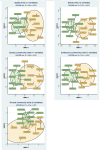Landscape to microhabitat: Uncovering the multiscale complexity of native and exotic forests on Terceira Island (Azores, Portugal)
- PMID: 40522958
- PMCID: PMC12169593
- DOI: 10.1371/journal.pone.0326304
Landscape to microhabitat: Uncovering the multiscale complexity of native and exotic forests on Terceira Island (Azores, Portugal)
Abstract
This study aims to identify the structural and compositional differences between native and exotic woodlands on Terceira Island, Azores. Based on landscape, habitat, and microhabitat analyses, remnants of native forests appeared to be associated with less accessible terrains. A more homogeneous structural complexity is exhibited, derived from the numerous branching patterns of the endemic vascular plant species. In contrast, exotic forests exhibit structural heterogeneity driven by mixed non-indigenous vascular plant species as a result of human actions such as afforestation and latter invasion of exotic tree species, after abandonment of the agricultural use. The ground and canopy layers in exotic forests were more invaded by non-indigenous species, while the understory demonstrated greater resilience by being mostly composed of indigenous species. Our findings highlight the structural and ecological differences between native and exotic woodlands, reflecting the historical transformation of forest cover in the Azores. These insights emphasize the importance of long-term monitoring and structural assessments in informing conservation efforts aimed at preserving native forests and managing invasive species in exotic woodlands.
Copyright: © 2025 Lhoumeau et al. This is an open access article distributed under the terms of the Creative Commons Attribution License, which permits unrestricted use, distribution, and reproduction in any medium, provided the original author and source are credited.
Conflict of interest statement
The authors have declared that no competing interests exist.
Figures





Similar articles
-
SLAM Project - Long Term Ecological Study of the Impacts of Climate Change in the natural forest of Azores: I - the spiders from native forests of Terceira and Pico Islands (2012-2019).Biodivers Data J. 2021 Sep 1;9:e69924. doi: 10.3897/BDJ.9.e69924. eCollection 2021. Biodivers Data J. 2021. PMID: 34566453 Free PMC article.
-
Vertical distribution of arthropod assemblages in native and exotic forests of Terceira Island (Azores, Portugal).Biodivers Data J. 2025 May 20;13:e154240. doi: 10.3897/BDJ.13.e154240. eCollection 2025. Biodivers Data J. 2025. PMID: 40438082 Free PMC article.
-
SLAM Project - Long Term Ecological Study of the Impacts of Climate Change in the natural forest of Azores: IV - The spiders of Terceira and Pico Islands (2019-2021) and general diversity patterns after ten years of sampling.Biodivers Data J. 2022 Nov 4;10:e96442. doi: 10.3897/BDJ.10.e96442. eCollection 2022. Biodivers Data J. 2022. PMID: 36761513 Free PMC article.
-
Resilience and restoration of tropical and subtropical grasslands, savannas, and grassy woodlands.Biol Rev Camb Philos Soc. 2019 Apr;94(2):590-609. doi: 10.1111/brv.12470. Epub 2018 Sep 24. Biol Rev Camb Philos Soc. 2019. PMID: 30251329 Review.
-
Transitional forestry in New Zealand: re-evaluating the design and management of forest systems through the lens of forest purpose.Biol Rev Camb Philos Soc. 2023 Aug;98(4):1003-1015. doi: 10.1111/brv.12941. Epub 2023 Feb 19. Biol Rev Camb Philos Soc. 2023. PMID: 36808687 Review.
References
-
- Sedjo RA. The carbon cycle and global forest ecosystem. Water Air Soil Pollut. 1993;70(1–4):295–307. doi: 10.1007/bf01105003 - DOI
-
- Thompson ID, Okabe K, Tylianakis JM, Kumar P, Brockerhoff EG, Schellhorn NA, et al. Forest biodiversity and the delivery of ecosystem goods and services: translating science into policy. BioScience. 2011;61(12):972–81. doi: 10.1525/bio.2011.61.12.7 - DOI
MeSH terms
LinkOut - more resources
Full Text Sources

